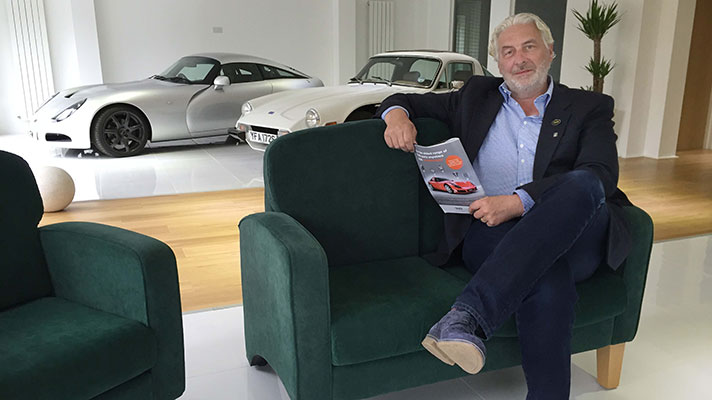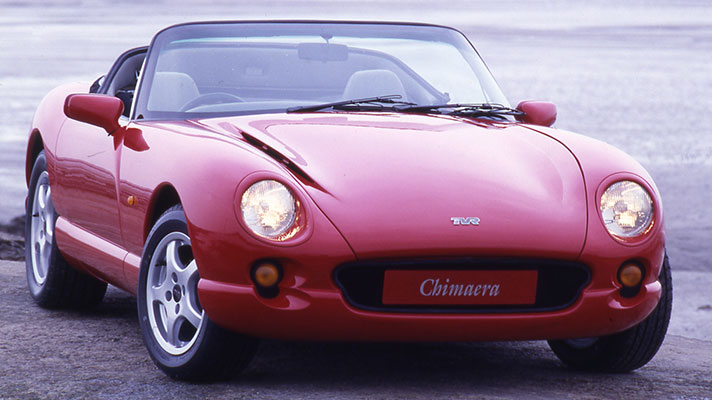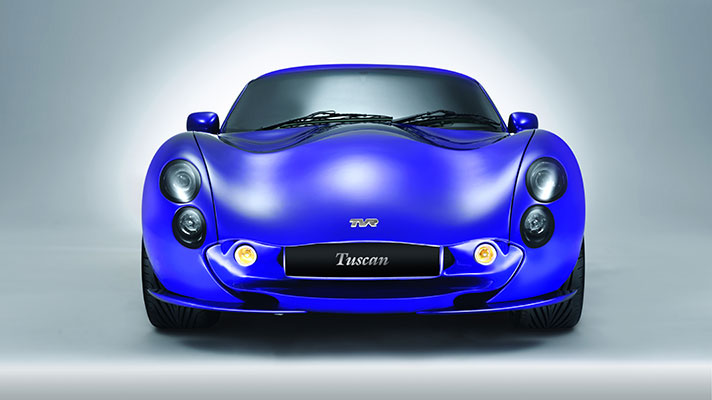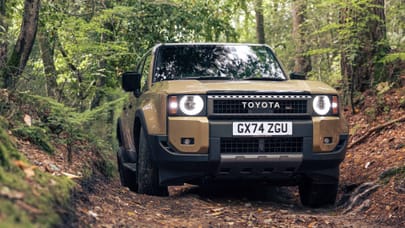
New TVR 'will cost from £55,000' and launch in 2017, says boss
TVR will celebrate its 70th anniversary in 2017 in the best way possible: by unleashing an all-new, back-to-basics sports car.
It will be no mean feat. Blackpool-based and rather beardy niche Brit car maker TVR enjoyed a typically rollercoaster existence for most of its life. But in the 1990s, TVR saw its stock go through the roof thanks to a series of splendidly deranged rocketships, like the Chimaera, Griffith and Cerbera (pictured above).
The company was piloted by the eccentric and much-missed Peter Wheeler, who ploughed such a furiously idiosyncratic furrow that even his dog Ned was said to be part of the design team. Rarely an issue of the magazine or an episode of TopGear went by without someone rhapsodising about these wonderful cars. Usually out of the side window.
Wheeler bailed in 2004 after selling up to youthful Russian son-of-an-oligarch, Nikolay Smolensky. A difficult, decade-long hiatus followed, until news broke in 2013 that a new consortium, headed by former computer games company entrepreneur Les Edgar, had rescued the company from a seemingly terminal decline. More radio silence ensued. Then earlier this week TG.com confirmed that New TVR would unite former Brabham and McLaren technical genius Gordon Murray with engineering powerhouse Cosworth. This is very good news indeed.
Allergic to hype and determined to get on with the job rather than spewing a load of hot air, TG.com still managed to pin down Les Edgar for a debrief. We have reason to believe that, after all TVR's ups and downs, the best is yet to come.
TG.com: TVR. Gordon Murray. Cosworth. You've answered a very specific set of prayers there...
Les Edgar: I think we have, mine included. The response has been overwhelmingly positive. But how else could we bridge the credibility gap when it came to bringing TVR back from the dead?
TG.com: This is a big project. Clearly you're a man who's up for a challenge.
LE: With the partners we have, how could you not be? We started by looking at many, many people, but came to the conclusion that you have to go for the best. Whether we could afford the best was another issue. When we approached Gordon Murray and Cosworth, they were incredibly excited and motivated by the prospect. That motivated us even more, not that we needed it.
TG.com: TVRs have always majored on raw thrills. What's your feeling about the latest generation of high performance cars? Is the time right for something a bit more primal?
Top Gear
Newsletter
Thank you for subscribing to our newsletter. Look out for your regular round-up of news, reviews and offers in your inbox.
Get all the latest news, reviews and exclusives, direct to your inbox.
LE: The over-sized, over-hyped, over-priced thing does grate with me a bit, although clearly the current wave of supercars has its place. The more complex systems you build into a car, the more things there are to go wrong. But it also detracts from the driver experience. Personally speaking, I'd rather feel through the seat of the pants what's happening with a car than be informed by a computer display.
Not to say that there isn't a place for that - probably - just not inside the new TVR. A car like the Nissan GTR is fantastic, but it's a computer on wheels at the end of the day, so when you drive it you have no idea how good a driver you are. All you know is that it's a brilliant car.
TG.com: What can you tell us about the new TVR, due in 2017?
LE: It'll be similar in size or possibly a little bigger than the last generation of TVRs. The chassis and hard points were all confirmed a year ago, and the body stylists haven't been allowed to impinge on that in any way. It'll be a British sports car - powered by a big engine, rear-wheel drive, great looks, lots of noise. The Britishness of it is really important to the brand. TVR owners are in it together, regardless of the model they have. There's a real sense of community, a classlessness. I like that. It's certainly the approach we're trying to take with the new car.
TG.com: TVR flourished in the 1990s under Peter Wheeler, partly because ‘uncompromising' was pretty much his middle name. Do you see yourself in that lineage?
LE: TVR wouldn't be what it is today if it wasn't for Peter Wheeler, and his character was part of it. But it also had its drawbacks, and when you decide to build your own engine and basically kill the company, well that's clearly a mistake. I suspect Peter struggled with the lingering idea that TVR was a kit car company - which it never was, of course - and one way to combat that was to build his own engine. It was an admirable move, but it coincided with a time when every other car company in the world was saying, ‘we should go to the experts in every area.' When the customer looks at a brake caliper, they want to know it's come from a specialist.
TG.com: What can you tell us about the new engine? [Ford's Mustang 5.0-litre V8 is the front runner]
LE: The credibility issue is relevant here again. We knew if we revived the Speed Six - and we looked at doing so - it wouldn't last long in terms of emissions demands. So we had to base our engine on a block that would be ultra reliable, and devised a short-list. The work Cosworth is doing will transform the base block, to the extent that where it actually comes from is almost irrelevant. Which is why I won't say anything else...
TG.com: OK. What can we expect from the car's design? A Griffith reboot? Or something more radical?
LE: The Griffith is stunning. We have one here, along with a Sagaris and a T350C, and we've tried to work out what they have in terms of common design DNA. Not that much, is the answer. I don't think the new TVR should be an updated Griffith, or as outrageous as the Sagaris, as much as I love it. We're looking at a more modern approach than a retro one.
TG.com: Does that also extend to the build process? Gordon Murray's iStream suggests a more ‘techy' approach.
LE: It's techy but simple. The last TVRs used a spaceframe reinforced with composite panels, so the iStream idea follows on very nicely from that. But the main reason we've chosen iStream is that it's a very scaleable process. The crash structure you can build around the iStream frame is amazingly high performance, and the torsional rigidity will be superb. I don't think we're going particularly hi-tech. I think people just want to know if the chassis is going to be awesome. TVRs have always been light. What we're really doing is refining the construction methods we already had. Gordon has done the ultimate refinement of a spaceframe-type approach.
TG.com: How's he been? He's another famously uncompromising individual...
LE: Working with Gordon is fantastic. He is demanding, but he's not demanding to be pernickety or because it's the way he's always done things and he won't change. He explains why it's done a certain way. It never ceases to amaze me when the man who more or less invented modern aerodynamics stands in front of a white board and explains why the ground effect is going to be awesome on this car... what's not to like?
TG.com: What about the truism that says to make a small fortune in the car business you have to start with a large one?
LE: [laughs] No, that's motor racing.
TG.com: But you've talked about having a 10-year business plan, right?
LE: Yes. But that's standard in the car business, although who knows what could happen in that time. That's fine, so long as you're fleet of foot and can read the changes as they happen. Reducing start-up costs is another big benefit of iStream. We're making some big assumptions about our costs, our likely volumes, and what sort of appetite there might be for this car. Some online forums have said, ‘great, if they can sell a car for £30k, I'll have one', which makes me wonder about some of the expectations. You can buy a Ginetta for that, and we are not building a Ginetta. Lotus makes a well-priced car, until you get to the Evora.
Our new car will be more of a GT, a two-seater coupe you might occasionally take on the track. There will be great materials inside, and we'll do something spectacular with the interior design. The attention to detail will also be second-to-none. It has to be. Frankly, we'll be doomed if it isn't.
TG.com: Do you want to take sales away from Aston Martin, Lotus, Porsche?
LE: Take back, you mean? In Europe the segment we're looking at is maybe 55 to 75,000 cars per year. I don't think we'll expand that, but I do think there's a gap for us. Our volume aspirations are very realistic - around 1500 cars per year. The area we're looking at - £55-£85k - is a good place to be, for a relatively small volume car maker. We're focused on the UK, with expansion into the hot spots for our brand in Europe. We've stress-tested it, so that we know how much we can scale it back if we need to, without losing our shirt. But is it a risk? Yes, of course it is.
TG.com: Is the TVR fanbase - and its fanaticism - an advantage or a hindrance?
LE: It's a massive advantage. The brand punches so far above its weight. We suspected that was the case when we bought the company, but we still under-estimated the depth of feeling that surrounds TVR. As easy as it is to get carried away, we intend to keep our feet on the ground. I believe we can do it, although there are clearly going to be challenges. Money will always be one of the challenges, but there's lots of that out there. There's only one TVR.
Trending this week
- Car Review
BMW 1 Series
- Top Gear's Top 9
Nine dreadful bits of 'homeware' made by carmakers










